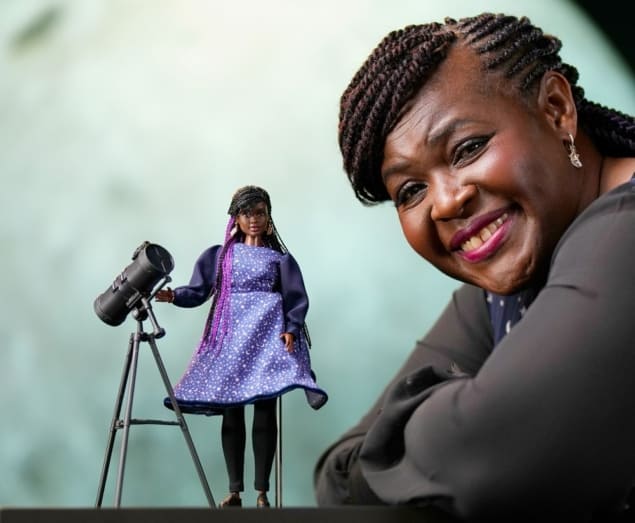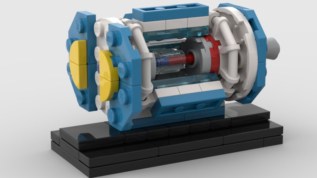
From the fastest woman to run across the US to the mechanics of dancing peanuts, physics has had its fair share of quirky stories this year. Here is our pick of the best 10, not in any particular order.
I’m a Barbie…role model
This year Barbie created “one-of-a-kind role model dolls” to honour seven female leaders in science, technology, engineering and medicine. They included Susan Wojcicki, chief executive of YouTube, German microbiologist Antje Boetius from the Max Planck Institute for Marine Microbiology, as well as the UK space scientist and science educator Maggie Aderin-Pocock. The Barbie doll inspired by Aderin-Pocock, which won’t be on general sale, has a starry dress reminiscent of the night sky and comes with a telescope accessory for stargazing. Aderin-Pocock, who chancellor of the University of Leicester, says that when she heard the news of a Barbie in her honour she “danced around the living room” with her daughter. “When I was little, Barbie didn’t look like me, so to have one created in my likeness is mind-boggling,” says Aderin-Pocock. “It’s such an honour to receive this doll that is celebrating my achievements.”
Nuclear effects
Many physicists will have enjoyed this year’s Hollywood blockbuster. We’re not talking about Barbie, but the biopic Oppenheimer, directed by Christopher Nolan. In particular, many would have appreciated the film’s visual effects, such as the detonation of the first atomic bomb. Nolan claims however, that no computer-generated imagery (CGI) was used to create these scenes. To check if Nolan is telling the truth, independent filmmaker William Baker and colleagues had a go at recreating the effects without using CGI. With just a few simple ingredients, such as water and pigment powder, they managed to get impressively near to the close-up scene of burning fuel as well as the nuclear explosion itself. “I think we figured out exactly how Nolan’s team did these shots,” Baker concludes.
Shape-shifting robot
In the classic 1991 film Terminator 2: Judgment Day, Arnold Schwarzenegger’s robot assassin, the T-800, comes up against the T-1000 Advanced Prototype, which is made from a liquid metal called “mimetic polyalloy” that can reform into any shape it touches. Researchers in China and the US this year came close to recreating in the lab some of the T-1000’s special abilities. They did this by designing miniature robots that can rapidly and reversibly shift between liquid and solid. First, they embedded magnetic particles in gallium, a soft metal with a low melting point. Then they applied an alternating magnetic field, which not only heats the magnetic particles, making the body become a liquid, but also allows it to become mobile. In one video released by the team, a 10mm-tall LEGO-like minifigure liquifies to ooze before passing through bars in a mocked-up cell. It then cools inside a mould before the figure reforms back into its original shape.
Escape from physics
Would you fancy your chances in a physics-based escape room? Well, now you can try thanks to a new, free-to-play online game. Designed by Dan Cooper, a chemistry teacher from south-west England, Escape the Lab was funded by the Institution of Engineering and Technology. The game is based at the Rutherford Appleton Laboratory in the Oxfordshire, UK, where players navigate the RAL Space centre and tackle a series of challenges, such as calculating the kinetic energy of an Ariane rocket just after launch. Your aim is to reveal a lost password that will enable engineers to launch the latest mission. Along the way, players meet members of staff at the lab and talk about their careers. Cooper says that the game’s challenges are based on the specification of a GCSE physics course but that the main aim of the project is to showcase engineering careers to physics students. “It will hopefully increase interest in physics and engineering,” Cooper says.

Build your own Belle
There have already been LEGO versions of CERN’s Large Hadron Collider, the James Webb Space Telescope and even a Kibble balance and now you can add a “micro” version of the Belle II experiment at the KEK particle-physics lab in Japan. Created by a team led by Torben Ferber at the Karlsruhe Institute of Technology, the model has 75 pieces and apparently takes less than 10 minutes to construct. Despite its tiny size, however, the design still includes details of Belle II’s particle identification system as well as the blue and yellow coloured octagon shape of the detector. In case you get the urge to create a model for your desk, Ferber and colleagues have published a parts list and building instructions.
Lost Lemaître film
Georges Lemaître, who died in 1966, is best known for his pioneering work on the expanding universe and the Big Bang. A professor of physics at Belgium’s Catholic University of Louvain, he was also – rather unusually – a Catholic priest. This year a rare video interview of Lemaître emerged that was recorded two years before his death. The video, which was first broadcast in 1964, is about 20 minutes long. Most of it was thought to be lost, but a mislabelled reel has since been found and has been uploaded to the Internet by the Belgian broadcaster VRT. Speaking in his native French and subtitled in Flemish, Lemaître talks about cosmology as well as religion. Notably, the interview was done before the discovery of the cosmic microwave background – which provided strong observational support for his ideas.
Twist and shake
You may remember the great bottle flipping craze of 2016, which saw people film themselves throwing a partly filled plastic drinks bottle into the air so that it rotates and – with a bit of skill – lands upright. Now here’s a new twist: take a plastic bottle, fill it partially with water, and then set it spinning about its long axis. When you drop the bottle, you’ll find it hardly bounces. Researchers in Chile have now found that the rotation forces water up along the walls of the bottle, which, upon impact, generates a vertical jet in the centre of the liquid that acts as a shock absorber, soaking up much of the kinetic energy. The team also created a theoretical model that agrees with the experimental findings and correctly predicts that the most effective suppression of bouncing occurs with the highest rotation rates – up to 12.7 revolutions per second – and with the bottle about 40% full.
Dancing peanuts
If you drop a peanut into a glass of beer, it will sink to the bottom of the glass. Yet after a few moments the nut will float to the surface of the beer, where it will remain for a few moments before it sinks and the process repeats again. Researchers in Germany have now studied the “beer-dancing peanut” by painstakingly dropping peanuts into a litre of lager. They found that the bubbles from the beer accumulate on the surface of the peanut until it is buoyant and then floats to the surface. When the peanut reaches the surface, its rotation makes the bubbles burst and causes the nut to sink back down. The process repeats itself for a remarkable 150 minutes before the peanut finally comes to rest.

Underground icons
Transport for London – which runs the London Underground – partnered with the Royal Academy of Engineering (RAE) to create a Tube-style map depicting famous people in the history of engineering. Created to celebrate National Engineering Day on 1 November, the map showcases 274 engineers, including Hertha Ayrton (in place of the Bond Street tube stop), Alan Turing (Goodge Street) and Alexander Graham Bell (Regent’s Park), while the Nobel-prize-winning physicist and fibre-optics pioneer Charles Kao is in place of Harrow-on-the-Hill. The tube lines have also been rebadged to reflect key areas of engineering such as Life and Health in place of the Central Line, Energy and Power (Hammersmith and City) and Computing, Technology and AI (Northern). “The work of engineers often goes unrecognized,” says RAE chief executive Hayaatun Sillem, who thinks the map will “uncover the stories of ingenuity, teamwork and persistence that have made their mark on the city around us”.
On the run
Physicists often have talents that stretch well beyond academia – and Harvard University’s Jenny Hoffman is no exception. Hoffman, who studies the electronic properties of exotic materials, this year became the fastest woman to run across the US. She took just 47 days, 12 hours and 35 minutes to make the 5000 km journey from San Francisco to New York City. Astonishingly, she beat the previous record time (set by Sara Villines in 2017) by more than a week. This was Hoffman’s second attempt – in 2019 she got just over 4100 km from the California coast before a knee injury brought her to a halt in Ohio. Hoffman told the Harvard Gazette that despite the amount of time she spent alone she didn’t think about physics. “I love my students, and I feel really grateful that I have a great group of creative people who work well as a team, and even while I was gone, they got the science done,” she says.
You can be sure that next year will throw up its fair share of quirky stories from the world of physics. See you next year!
- SEO Powered Content & PR Distribution. Get Amplified Today.
- PlatoData.Network Vertical Generative Ai. Empower Yourself. Access Here.
- PlatoAiStream. Web3 Intelligence. Knowledge Amplified. Access Here.
- PlatoESG. Carbon, CleanTech, Energy, Environment, Solar, Waste Management. Access Here.
- PlatoHealth. Biotech and Clinical Trials Intelligence. Access Here.
- Source: https://physicsworld.com/a/the-10-quirkiest-stories-from-the-world-of-physics-in-2023/
- :has
- :is
- :not
- :where
- $UP
- 1
- 10
- 12
- 130
- 150
- 178
- 20
- 2016
- 2017
- 2019
- 2023
- 35%
- 5000
- 75
- a
- About
- Academia
- Academy
- Accumulate
- achievements
- across
- acts
- add
- advanced
- After
- again
- against
- agrees
- AI
- aim
- AIR
- Alan
- Alan Turing
- Alexander
- allows
- alone
- along
- already
- also
- amount
- an
- and
- any
- applied
- ARE
- areas
- around
- AS
- assassin
- At
- atomic
- attempt
- Axis
- back
- background
- baker
- Balance
- bars
- based
- BE
- beat
- became
- become
- been
- beer
- before
- Bell
- BEST
- between
- Beyond
- Big
- Big Bang
- Bit
- blockbuster
- Blocks
- Blue
- body
- bomb
- bond
- Bottom
- broadcast
- brought
- Building
- but
- by
- calculating
- california
- called
- came
- CAN
- careers
- case
- causes
- celebrate
- Celebrating
- cell
- central
- centre
- challenges
- chances
- Charles
- check
- chemistry
- chief
- Chief Executive
- Chile
- China
- Christopher
- City
- claims
- classic
- click
- Close
- Coast
- colleagues
- comes
- computer-generated
- computing
- concludes
- construct
- cooper
- correctly
- Cosmology
- Course
- create
- created
- Creative
- Dancing
- day
- Days
- Death
- depicting
- Design
- designed
- designing
- desk
- Despite
- details
- DID
- died
- directed
- discovery
- done
- down
- drinks
- Drop
- Dropping
- Earlier
- Effective
- effects
- Electronic
- embedded
- emerged
- enable
- energy
- Engineering
- Engineers
- England
- escape
- ETP
- Even
- exactly
- exception
- executive
- Exotic
- expanding
- experiment
- experimental
- explosion
- fair
- famous
- fastest
- feel
- female
- few
- field
- Figure
- figured
- fill
- filled
- Film
- Finally
- Find
- findings
- First
- Float
- For
- Forces
- found
- Francisco
- French
- from
- Fuel
- full
- funded
- game
- Games
- General
- generates
- German
- Germany
- get
- glass
- Go
- Goes
- gone
- got
- graham
- grateful
- great
- Group
- had
- harvard
- Have
- he
- Health
- heard
- her
- here
- highest
- his
- history
- Hollywood
- Hopefully
- HOURS
- How
- However
- HTTPS
- i
- icons
- ideas
- Identification
- if
- ii
- image
- Impact
- in
- included
- includes
- Including
- Increase
- independent
- information
- ingenuity
- injury
- inside
- inspired
- Institute
- Institution
- interest
- Internet
- Interview
- into
- issue
- IT
- ITS
- itself
- james
- James Webb Space Telescope
- Japan
- journey
- jpg
- just
- Key
- Key Areas
- known
- lab
- laboratory
- lands
- large
- latest
- launch
- leaders
- Led
- less
- Life
- like
- Line
- lines
- Liquid
- List
- little
- living
- London
- Long
- Look
- look like
- lost
- love
- Low
- made
- Magnetic field
- Main
- make
- MAKES
- Making
- managed
- many
- map
- marine
- mark
- materials
- mattel
- max
- max-width
- May..
- me
- mechanics
- medicine
- Meet
- Members
- metal
- micro
- Minutes
- Mission
- Mobile
- model
- Moments
- more
- most
- much
- my
- National
- native
- Navigate
- Near
- New
- New York
- new york city
- news
- next
- night
- no
- notably
- November
- now
- nuclear
- observational
- Octagon
- of
- often
- Ohio
- on
- ONE
- One-of-a-Kind
- online
- only
- open
- order
- original
- our
- out
- over
- own
- painstakingly
- Park
- particular
- partnered
- parts
- Passing
- Password
- People
- per
- persistence
- Physics
- Physics World
- pick
- pieces
- pioneer
- Pioneering
- Place
- plastic
- plato
- Plato Data Intelligence
- PlatoData
- players
- Point
- power
- Predicts
- previous
- process
- Professor
- project
- properties
- prototype
- provided
- published
- rapidly
- RARE
- Rates
- rather
- Reaches
- really
- receive
- record
- recorded
- reflect
- reform
- released
- religion
- remain
- remarkable
- remember
- reminiscent
- researchers
- REST
- reveal
- robot
- robots
- Rocket
- Role
- Room
- royal
- Run
- runs
- sale
- San
- San Francisco
- saw
- says
- scene
- scenes
- Science
- Scientist
- Second
- Section
- see
- Series
- set
- seven
- Shape
- Share
- she
- shift
- shots
- showcase
- Simple
- since
- Size
- skill
- Sky
- small
- So
- Soft
- solid
- some
- Space
- speaking
- special
- specification
- spent
- Staff
- starry
- Still
- Stop
- Stories
- street
- strong
- Students
- studied
- studies
- such
- support
- suppression
- sure
- Surface
- Susan
- system
- tackle
- Take
- takes
- talents
- Talk
- talking
- Talks
- team
- teamwork
- Technology
- telescope
- telling
- than
- Thanks
- that
- The
- the UK
- the world
- their
- themselves
- then
- theoretical
- These
- they
- think
- Thinks
- this
- this year
- thought
- Through
- Throwing
- thumbnail
- time
- to
- told
- took
- touches
- transport
- true
- truth
- try
- turing
- twist
- two
- Uk
- underground
- Universe
- university
- until
- uploaded
- upon
- us
- used
- using
- version
- versions
- vertical
- Video
- visual
- was
- Water
- Way..
- we
- week
- WELL
- when
- which
- while
- WHO
- will
- william
- with
- without
- woman
- Work
- world
- would
- year
- years
- yet
- york
- You
- Your
- youtube
- zephyrnet













